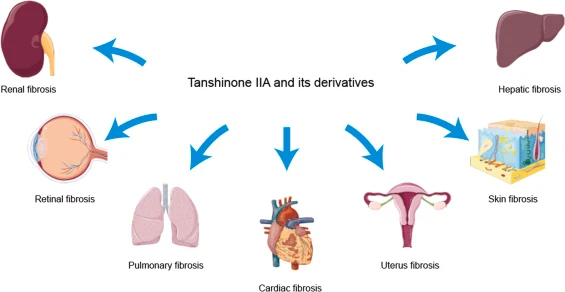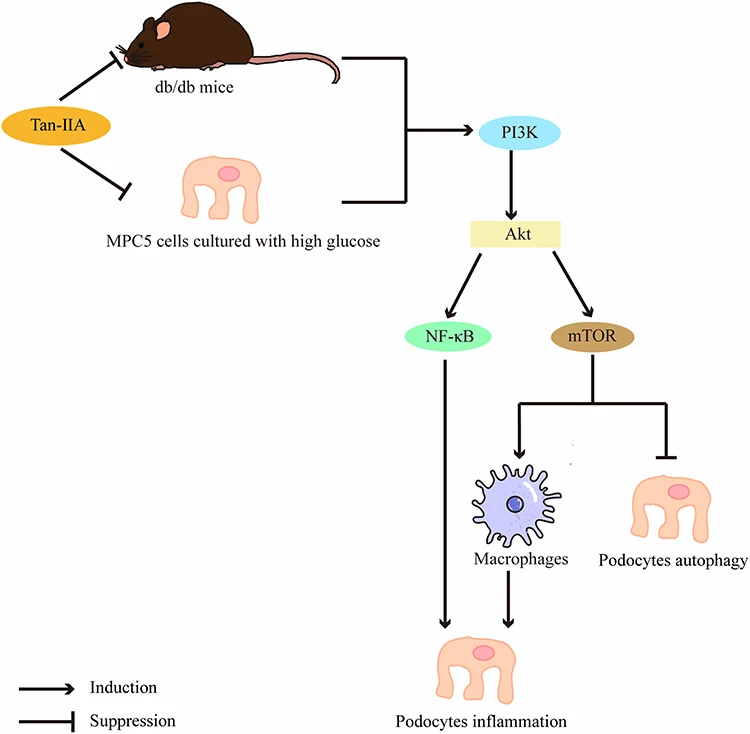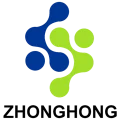Tanshinone IIA is a potent, naturally occurring diterpene quinone compound primarily extracted from the roots of Salvia miltiorrhiza Bunge, a traditional Chinese medicinal herb widely known as Dan Shen or Red Sage. For centuries, Dan Shen has been revered in Traditional Chinese Medicine (TCM) for promoting blood circulation and addressing cardiovascular concerns. Tanshinone IIA is recognized as one of its most pharmacologically active and well-studied components, driving significant modern scientific interest.
Key Ingredients & Source:
- Primary Source: Roots of Salvia miltiorrhiza (Dan Shen).
- Chemical Class: Lipophilic diterpene quinone (a specific type of chemical structure).
- Related Compounds: Often found alongside other bioactive tanshinones like Tanshinone I, Cryptotanshinone, and Dihydrotanshinone I. Supplements or extracts may specify the standardized percentage of Tanshinone IIA.

Efficacy & Benefits (What Does the Science Suggest?):
Research, primarily in preclinical (cell and animal) studies, indicates Tanshinone IIA possesses a wide range of potential biological activities. Important Note: While human studies exist, they are often smaller-scale or preliminary. More large-scale clinical trials are needed to definitively confirm efficacy for specific conditions in humans. Key areas of investigation include:
- Cardiovascular Health: This is the most prominent area of research. Tanshinone IIA shows potential for:
- Protecting heart muscle cells from damage (e.g., after a heart attack).
- Improving blood flow and microcirculation.
- Reducing inflammation in blood vessels.
- Inhibiting abnormal smooth muscle cell proliferation (relevant to atherosclerosis).
- Exhibiting antioxidant effects against oxidative stress in cardiovascular tissues.
- Note: In some countries (like China), Tanshinone IIA sodium sulfonate injections are approved and used clinically for certain cardiovascular conditions like angina and stroke, but oral supplement efficacy requires more human data.
- Anti-inflammatory Effects: Modulates key inflammatory pathways (like NF-κB), potentially beneficial for various chronic inflammatory conditions.
- Antioxidant Activity: Scavenges harmful free radicals, protecting cells from oxidative damage.
- Neuroprotective Potential: Studies suggest possible protective effects on brain cells, with implications for conditions like Alzheimer’s and Parkinson’s disease (preclinical stage).
- Anticancer Properties: Demonstrates ability to inhibit proliferation and induce apoptosis (programmed cell death) in various cancer cell lines in vitro and in animal models. Human clinical application is still investigational.
- Liver Protection: Shows hepatoprotective effects in models of liver injury.
Effects in the Body:
Tanshinone IIA works through multiple complex mechanisms, including:
- Modulating signaling pathways involved in inflammation (NF-κB, MAPK).
- Acting as an antioxidant.
- Influencing cell cycle progression and apoptosis.
- Improving endothelial function (lining of blood vessels).
- Inhibiting platelet aggregation (blood clotting) under certain conditions.
How to Take It, Dosage Protocol & Daily Dose:

- Form: Available as oral supplements (capsules, tablets, powders), concentrated extracts, and in injectable forms (primarily prescription in specific regions like China).
- Standardization: Look for extracts standardized to a specific percentage of Tanshinone IIA (e.g., 5%, 10%, 20%+).
- Dosing Protocol (Oral Supplements – General Guidance ONLY):
- There is no universally established optimal dose. Doses used in research vary widely.
- Typical supplemental doses often range from 20 mg to 100 mg per day, sometimes divided into two doses. Always follow the specific dosage instructions on the product label.
- Crucial: Dosing depends heavily on the extract concentration, formulation, and individual health status. Self-prescribing high doses is dangerous.
- Best Practices:
- Consult a Healthcare Professional: This is non-negotiable. Discuss your health goals, current medications, and conditions with a doctor or qualified TCM practitioner before starting.
- Start Low: If advised to try it, begin with the lowest suggested dose.
- Consistency: Take it consistently as directed.
- Quality: Choose reputable brands that provide transparency on sourcing and standardization (e.g., COA – Certificate of Analysis). aiherba.com offers Tanshinone IIA supplements meeting these standards.
Side Effects & Safety:
Tanshinone IIA is generally considered safe at appropriate doses, but potential side effects exist:
- Common (Usually Mild): Gastrointestinal upset (nausea, diarrhea, stomach discomfort), dry mouth, mild dizziness, skin rash/itching.
- Serious (Rare, often linked to high doses/injections): Potential liver toxicity, kidney injury, severe allergic reactions, headache, drowsiness. Injectable forms carry additional risks.
- Blood Thinning: It may have anticoagulant/antiplatelet effects. Use extreme caution or avoid if taking blood thinners (warfarin, aspirin, clopidogrel, etc.) or have bleeding disorders. Discontinue before surgery.
- Drug Interactions: Potential interactions with blood pressure medications, other heart drugs, anticoagulants, antiplatelet drugs, and drugs metabolized by liver enzymes (CYP450 system). Disclose all medications to your doctor.

Applicable Population & Precautions:
- May be considered for: Individuals seeking cardiovascular support (under medical guidance), exploring antioxidant/anti-inflammatory support (research stage).
- Avoid or Use Only Under Strict Medical Supervision:
- Pregnant or breastfeeding women (safety not established).
- Children.
- Individuals with bleeding disorders or taking anticoagulant/antiplatelet drugs.
- Individuals scheduled for surgery.
- People with liver or kidney disease.
- Those taking medications with potential interactions (see above).
- Precautions:
- Never self-prescribe for serious conditions.
- Medical supervision is essential, especially for cardiovascular issues.
- Report any side effects to your healthcare provider immediately.
- Inform all your healthcare providers about your use of Tanshinone IIA.
Featured Snippet Targets:
- What is Tanshinone IIA? Tanshinone IIA is a bioactive compound primarily extracted from the roots of the Salvia miltiorrhiza (Dan Shen) plant, used in Traditional Chinese Medicine.
- What are the benefits of Tanshinone IIA? Research suggests potential benefits for cardiovascular health, anti-inflammatory effects, antioxidant activity, neuroprotection, and liver protection, primarily based on preclinical studies.
- How to take Tanshinone IIA? Typically taken as an oral supplement (capsules/tablets), standardized to a specific percentage. Doses often range from 20mg-100mg daily, but ALWAYS consult a healthcare professional and follow product/label instructions.
- What are the side effects of Tanshinone IIA? Possible side effects include stomach upset, dry mouth, dizziness, or rash. Serious risks include bleeding (especially with blood thinners), liver/kidney toxicity (rare), and drug interactions. Medical consultation is crucial.
People Also Ask (PAA):
- Is Tanshinone IIA safe? While generally safe at appropriate doses under guidance, it has potential side effects and significant drug interactions. Consult a doctor before use.
- Can Tanshinone IIA lower blood pressure? Some research suggests it may help improve vascular function, potentially contributing to blood pressure regulation. However, it’s not a substitute for prescribed medication, and interactions with BP drugs are possible.
- Does Tanshinone IIA thin the blood? Yes, it has demonstrated anticoagulant and antiplatelet effects in studies. It should not be combined with blood-thinning medications without strict medical supervision.
- Is Tanshinone IIA good for the heart? Preclinical and some clinical evidence suggests cardioprotective effects, including improving blood flow and reducing heart muscle damage. It’s used clinically in injectable form in some countries, but oral supplement efficacy requires more human data. Consult a cardiologist.
- Where does Tanshinone IIA come from? It is primarily extracted from the roots of the Salvia miltiorrhiza plant (Dan Shen or Red Sage).
Instant Answer:
Tanshinone IIA is a bioactive compound from Salvia miltiorrhiza (Dan Shen) studied for cardiovascular, anti-inflammatory, and antioxidant benefits. Consult a doctor before use due to potential side effects and drug interactions.
Where to Buy:
High-quality Tanshinone IIA supplements are available for purchase online at aiherba.com. For specific inquiries, contact: liaodaohai@gmail.com.
Summary:
Tanshinone IIA, derived from Salvia miltiorrhiza (Dan Shen), is a bioactive compound with significant research interest, particularly for cardiovascular health, antioxidant, and anti-inflammatory effects. While preclinical data is promising, more robust human clinical trials are needed. It is available as an oral supplement, but dosing must be individualized. Crucially, potential side effects and serious drug interactions (especially with blood thinners) necessitate consultation with a qualified healthcare professional before use. Never self-prescribe for serious conditions. Reputable sources like aiherba.com offer quality Tanshinone IIA products.
References:
- Zhou, L., Zuo, Z., & Chow, M. S. S. (2005). Danshen: An Overview of Its Chemistry, Pharmacology, Pharmacokinetics, and Clinical Use. The Journal of Clinical Pharmacology, *45*(12), 1345–1359.
- Wang, X., Morris-Natschke, S. L., & Lee, K. H. (2007). New developments in the chemistry and biology of the bioactive constituents of Danshen. Medicinal Research Reviews, *27*(1), 133–148.
- Gao, S., Liu, Z., Li, H., Little, P. J., Liu, P., & Xu, S. (2012). Cardiovascular actions and therapeutic potential of tanshinone IIA. Atherosclerosis, *220*(1), 3–10.
- Xu, S., & Liu, P. (2013). Tanshinone II-A: new perspectives for old remedies. Expert Opinion on Therapeutic Patents, *23*(2), 149–153.
- Hung, Y. C., Pan, T. L., & Hu, W. L. (2016). Roles of Reactive Oxygen Species in Anticancer Therapy with Salvia miltiorrhiza Bunge. Oxidative Medicine and Cellular Longevity, *2016*, 1–10.
- Zhang, Y., Jiang, P., Ye, M., Kim, S. H., Jiang, C., & Lü, J. (2012). Tanshinones: sources, pharmacokinetics and anti-cancer activities. International Journal of Molecular Sciences, *13*(10), 13621–13666.
- National Center for Biotechnology Information. PubChem Compound Summary for CID 164676, Tanshinone IIA. https://pubchem.ncbi.nlm.nih.gov/compound/Tanshinone-IIA
- Chan, T. Y. K. (2001). Interaction between warfarin and danshen (Salvia miltiorrhiza). The Annals of Pharmacotherapy, *35*(4), 501–504. (Highlights interaction risk).
